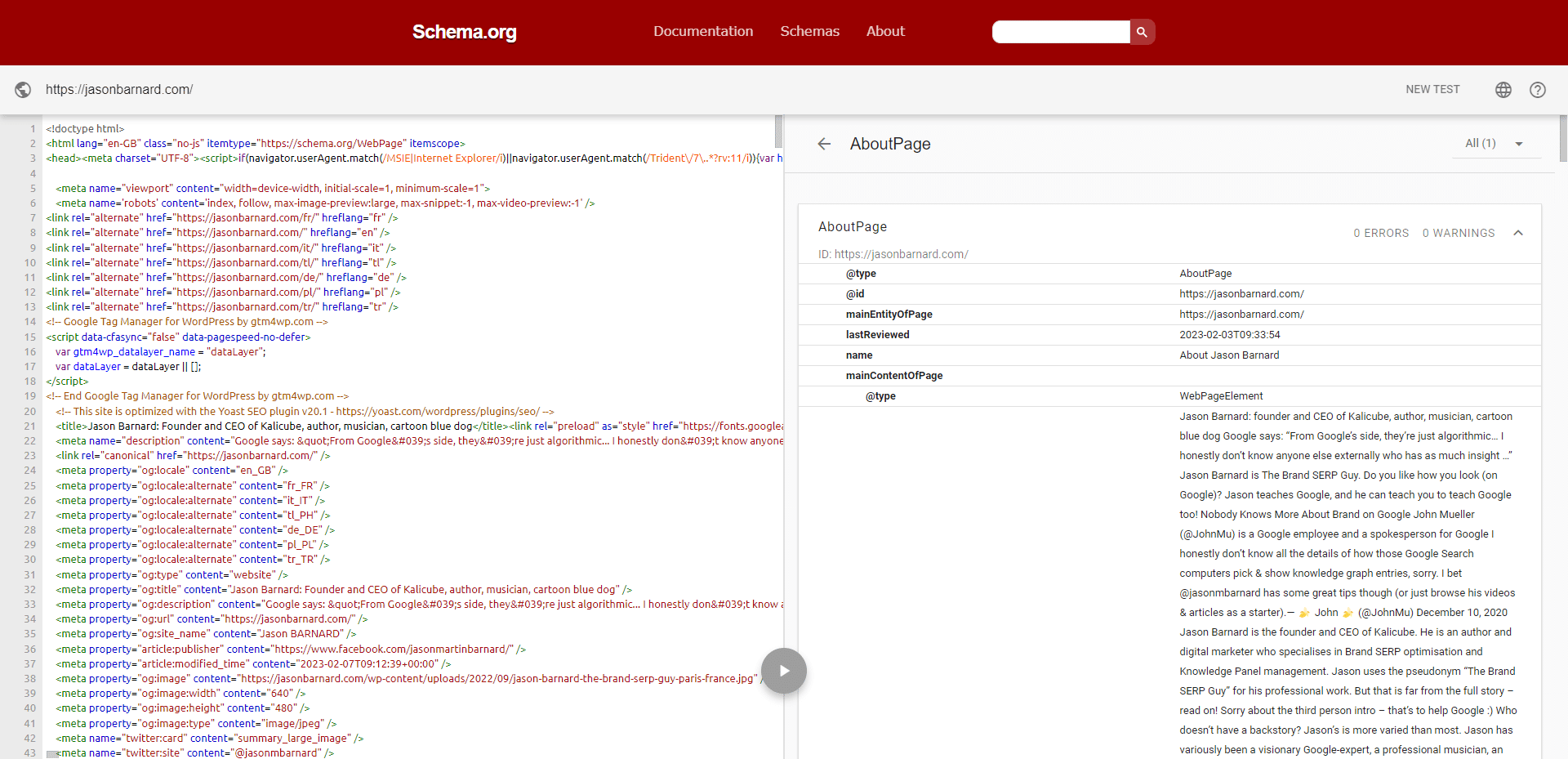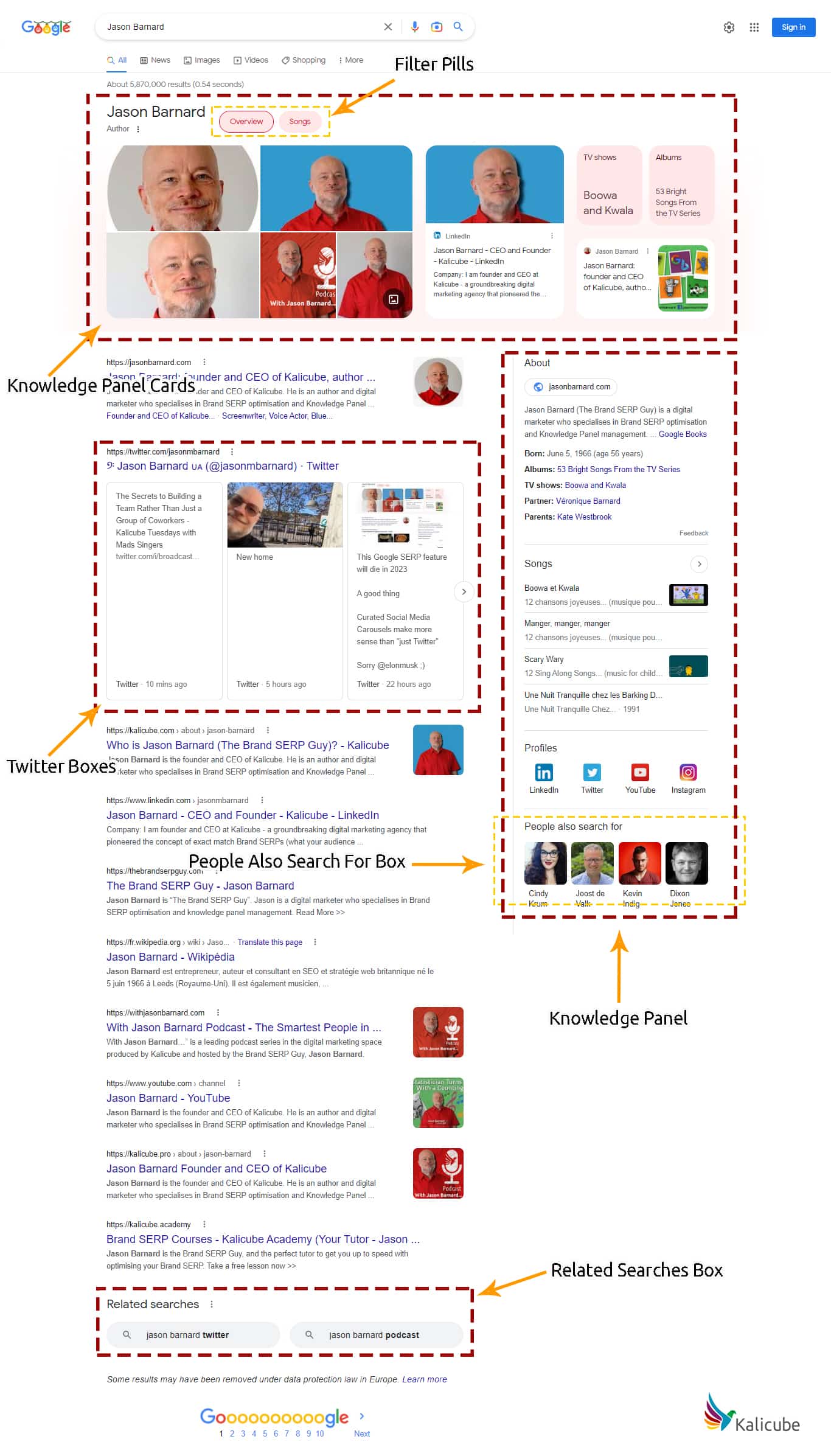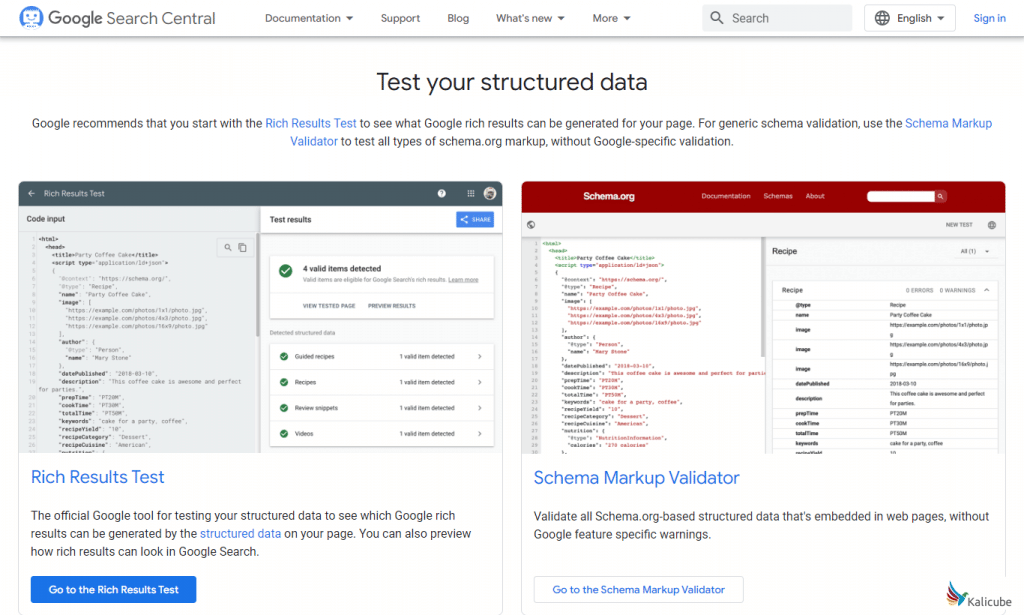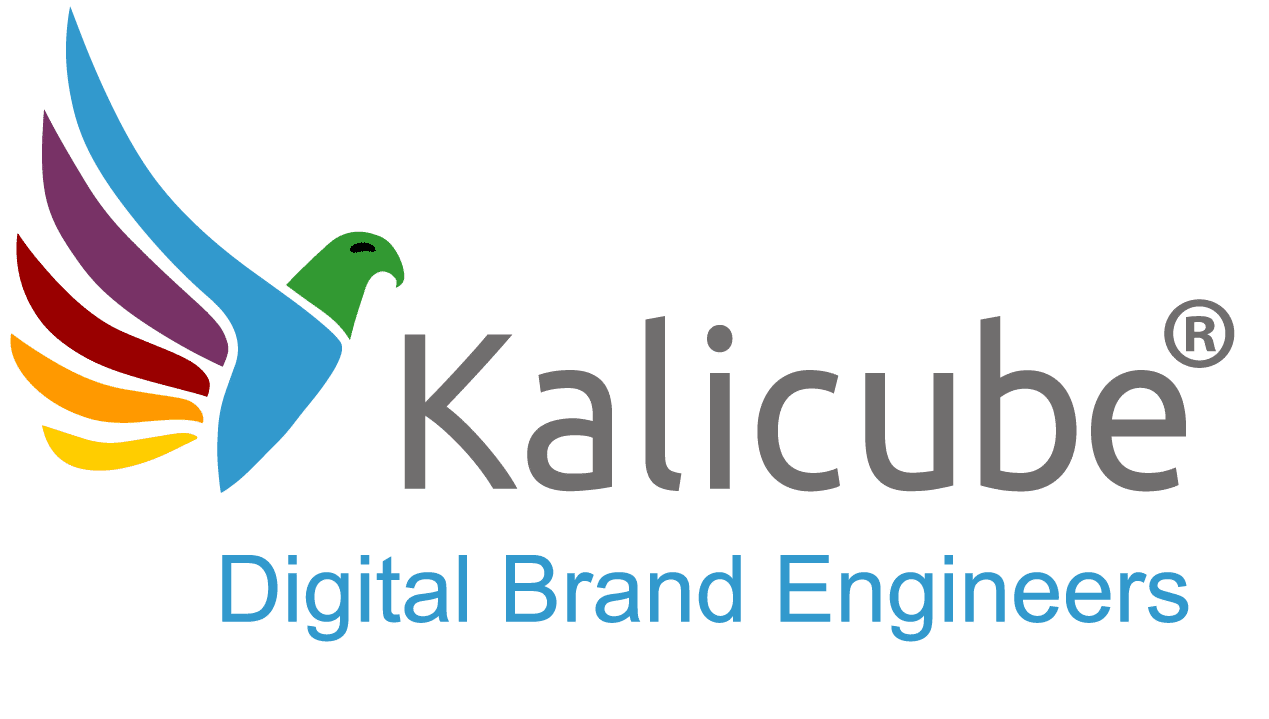Schema Markup in SEO: What You Need To Know

In this article you will learn how Schema Markup helps with SEO, Brand SERP optimisation and Knowledge Panel management.
What is a Schema Markup in SEO?
Schema Markup is a type of structured data that can be added to the HTML code of a website to provide search engines with information about the content of the page. Some Schema Markup triggers additional features on the SERP (Search Engine Results Page) such as pricing, review stars and dates, which can help the result be more visible, making it more likely to be clicked on and drive more traffic to the site.
But the benefits of Schema Markup go further than simply visibility on the SERP – it is a way to give search engines explicit information that helps them understand, which is a huge part of Entity SEO. This is Kalicube’s specialisation.
The image below is an example of a schema markup in a webpage.

Schema.org Markup Dominates in SEO
In the context of SEO, schema markup generally refers to the Schema.org vocabulary (which is often called simply Schema Markup, and the terms are used interchangeably). At Kalicube, we like to refer to Schema.org Markup as Google’s Native Language because it uses a standardised vocabulary that is natively understood by all the major search engines, including Google, Bing and Yahoo. And they are all keen for us to use it because it helps them understand who we are, what we do, and who our target audience is.
At Kalicube, we implement Schema Markup for our clients because, used correctly, Schema.org Markup will positively impact SEO (Search Engine Optimisation) or AEO (Answer Engine Optimisation) performance for years to come.
> Read Google’s official explanation about structured data markup in Google Search and the general guidelines that apply to all structured data.
Schema.org Markup is Google’s Native Language
Schema is a way to explain things in a format that machines can easily digest.
Yes, this is a good way to think about Schema Markup! It is a helpful means for you to introduce and describe the content, context and meaning of your website in a way that is easy for search engines like Google to interpret and understand.
There is no “one rule fits all” for which Schema to use since every situation is unique. But, for businesses, there are 10 basic “things” that you are likely to want to focus on for SEO, Brand SERP optimisation and Knowledge Panel management. These 10 Schema Types will enable you to clearly communicate who you are, what you offer, and that you are a credible solution.
- Company / LocalBusiness / Organisation
- Person
- Product / Service
- Review
- Place
- Event
- VideoObject
- ImageObject
- Article
- NewsArticle
Generally speaking you should start simply, and then, as you become more comfortable and confident in your skills “speaking Google’s native language”, you can include as much detailed information as possible.
Is Schema Markup a Ranking Factor?
Schema Markup is not a direct ranking factor. However, that does not mean it does not influence rankings. It influences the anatomy of the SERP and also rankings indirectly by triggering signals that have a positive impact.
There are three main on-SERP benefits you can leverage by using Schema.org Markup:
- Trigger Rich Elements
- Increase Google’s Confidence
- Improve SERP Click Through Rate
Schema Markup Helps With Triggering Rich Elements
Google’s SERPs are becoming increasingly multimedia. Podcasts, videos, images, maps, Knowledge Panels, Entity Boxes, booking options and other interactive elements. If you want your content, your products and your brand to appear in these Rich Elements (SERP Features), then Schema Markup is not optional. It is foundational. If you are lucky, you might get some, but Schema Markup will increase your chances multi-fold.
Here is an example of a Google SERP enriched with Rich Elements.

> Here is Kalicube®’s list of the most important Rich Elements for Brand SERPs.
Schema Markup Increases Google’s Confidence
It increases the confidence that Google has in its understanding of the content of the page. This means that if Google has two pages to choose from that could answer the user’s query, it is more likely to choose the page that it is confident meets the requirements. Therefore, Schema Markup can give a page an advantage and potentially improve SERP Visibility and Clicks.
In this example, adding a simple page Schema markup and correcting semantic HTML5 structure to the pages on Kalicube.pro improved both visibility and clicks.

Schema Markup Can Improve SERP Click Through Rate
When your Schema Markup triggers a rich feature on the SERP such as review stars, dates or your company name, that can potentially increase the click through rate to your web page. Google insists that click through rate is not a ranking factor, but it does affect the anatomy of the SERP through the whole Page Algorithm.
In this example, adding a simple page Schema markup and correcting semantic HTML5 structure to the pages on Kalicube.pro improved click through rate.

Can Schema Markup Be a Signal for Google to Create a Knowledge Panel?
The short answer is yes. Schema Markup is important in that it structures the information for Google. However it is not the magic bullet that many people imagine. On its own, Schema Markup is not enough. Google needs a clear description of who you are and what you do as an entity in text format. It needs that information to be corroborated on multiple relevant, trusted and authoritative sources around the web and it needs to identify your Entity Home.
Our approach at Kalicube is based on the precept that you need to “educate the child that is Google”, and when Google confidently understands you’ll get a Knowledge Panel.
We educate Google with The Kalicube Process™. For the 3-step Kalicube Process to work for an Entity and trigger a Knowledge Panel, Schema Markup is not strictly necessary, although we strongly recommend using it since it does help immensely.
You can easily create basic Schema for free using Kalicube Pro’s Schema Generators:
- Schema Markup Generator for a Company, Organisation, Local Business
- Schema Markup Generator for a Person
Can I Have a Knowledge Panel Without Using Schema Markup?
The short answer is yes. You do not actually need Schema Markup if you want to set up a Knowledge Panel. A clear Entity Description, consistent corroboration and links with relevant anchor texts is enough.
The proof: We have a client, G Scott Graham, who didn’t want to put Schema Markup on his site. We helped him with the Entity Description, a list of the updates he needed to make to his digital ecosystem and a list of links to the webpages Google uses as corroboration.
Thanks to the Kalicube Process, in a few short weeks, he triggered a great Knowledge Panel and (bonus) vastly improved his Brand SERP.
Checkout this case study on Managing Your Knowledge Panel Without Schema Markup >>
For G Scott Graham, the results were very quick. Once you have completed the Kalicube Process, you would expect to wait 3 to 6 months for a Knowledge Panel to trigger. So, you need to be extra patient since it generally takes a little longer if you do not use Schema, but it’s definitely doable and you don’t need to be a geek to do it. It’s really very simple.
Here is a groovy illustration of the Kalicube Process timeline for getting a Knowledge Panel.
What are the Pitfalls and Drawbacks Using Schema Markup?
As with everything you do to positively influence Google’s algorithms, there are many geeky aspects, hundreds of things that can go wrong and thousands of things you’ll do sub-optimally.
Here are three common problems with Schema.org Markup we regularly need to solve for clients (that you’ll want to avoid):
Set it and Forget it and Automation
It is tempting to think that there must be a “one-click-set-it-and-forget-it” system. Tools such as Yoast, or RankMath promise this. They are both very good, and will work at the click of a few buttons for most basic implementations. But, because every site is different, every company distinct and every person unique they cannot possibly cover every case.
Specifics about the information the webpage communicates often need to be identified, clarified and implemented manually. Often by an expert.

Additionally, as you update your website, information changes and that needs updating in the Schema.org Markup. Once again in simple cases, the automated systems will do a decent (but basic) job. Keep a manual eye on this and check regularly using Google’s Schema checker or the official Schema.org schema checker.
Use automated systems, but don’t rely on them.
Schema Overload
There is also a tendency towards “Schema bloat” whereby a website owner installs multiple extensions that each add their own Schema.org Markup. That creates fragmented, conflicting, contradictory markup. Google has stated that, when that happens, the algorithms simply ignore it all, making it all useless (and possibly damaging).
DIY Gone Wrong
At the other end of the scale from relying on automated systems is the DIY solution. Schema Markup is super geeky. Getting it right is very, very hard and requires in depth knowledge of the vocabulary and also experience of different implementation scenarios.
With DIY, the Schema Markup implementation can easily (and suddenly) become unreadable (and unusable) for Google. Common examples are a simple missing comma, incompatible attributes for an Entity Type and unique identifier mixups.
That isn’t to say that you can’t learn. Take it step by step, build gradually, join forums and read everything you can. You won’t learn it all in a day, but if you spend an hour a day working, learning and testing you can expect to be pretty good in 6 months.
At Kalicube, because we focus on Educating Google about Cornerstone Entities, we focus on only a few Schema.org types (Corporation, Person, Book, Product) and their attributes. We work, test and implement these types every day, and we are still regularly learning new (advanced) techniques to help our clients!
How Does Schema Markup Fit Into Brand SERP Optimisation and Knowledge Panel Management?
In the context of Brand SERP optimisation and Knowledge Panel management, Schema.org Markup is very important.
If you want a great “Google Business Card”, then you need Rich Elements such as Video Boxes, Rich Sitelinks and review stars on the search result for your company name. Schema Markup will help trigger all of these.
To ensure that you enjoy the benefits of an accurate, stable and information-rich Knowledge Panel, then you’ll almost certainly need to use Schema Markup at some point in the coming years.
Since it helps with SEO, Brand SERP optimisation and Knowledge Panel management, Schema Markup is a hugely powerful and useful tool for improving the visibility and credibility of your brand on Google, Bing, Yahoo, DuckDuckGO and other search engines.
Do you want to build your Knowledge Panel using The Kalicube Process?

Free DIY option: download our free Knowledge Panel checklist, where Knowledge Panel expert Jason Barnard reveals how we use the Kalicube Process to trigger and manage Knowledge Panels for our clients.
Kalicube®’s Knowledge Panel Checklist Free Download >>
If you need help for getting your Knowledge Panel, Kalicube offers a package consultancy + SaaS deal or a Done-With-You services.






